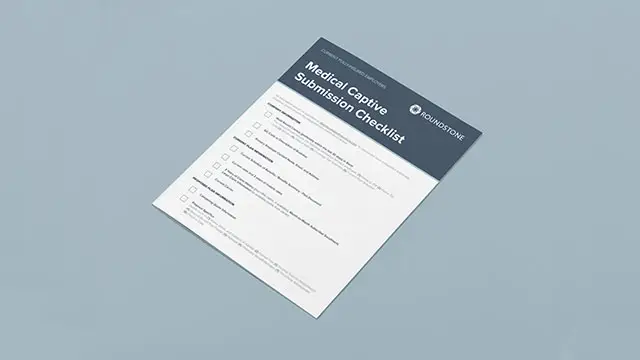Highlights
- Manage rising healthcare costs with control and healthcare cost transparency. Captive insurance empowers CFOs to take charge of healthcare cost containment with control, flexibility, and transparency.
- Customize health plans for specific employee needs. Group captives offer the ability to customize health plans for specific employee needs.
- Leverage detailed claims data for data-driven decisions. Access to detailed claims data enables data-driven decisions and cost-saving measures.
- Achieve predictable budgeting for long-term stability. Predictable budgeting with a self-funded plan allows for long-term financial stability.
- Take control of your employee health benefits program. Self-funding with Roundstone can help you achieve high-quality healthcare benefits with improved employee satisfaction — without breaking the bank.
As a CFO, you’re all too familiar with the headaches of traditional health insurance — rising costs, zero control, and a constant strain on your budget.
With premiums rising 7% in the past year alone, it’s time for a change.
Self-funding through a group captive puts you back in control. With access to claims data and financial performance, this innovative approach allows you to manage your company’s healthcare expenses with transparency and flexibility.
Learn how joining a group medical captive can help you turn healthcare costs for your company and your employees into a controllable, predictable part of your financial strategies.
The Power of Control in Healthcare Cost Containment
Gain control over healthcare spending. Group captives provide a powerful solution for companies seeking to take control of their healthcare spending. In a group captive, multiple businesses pool their resources to share the risk of health claims through a self-funded insurance arrangement. This model provides company health benefits that traditional insurance plans can’t match, including customization, transparency, and flexibility.
Customization
One advantage of group captives is the ability to customize health plans to meet the specific needs of your employees. Unlike traditional insurance plans, which often adopt a one-size-fits-all approach, captives allow you to choose the services and coverage that best suit your workforce.
You can select your service providers, manage plan design, and create well-being programs that align with your company’s goals. This level of personalization allows you to offer the best possible benefits while maintaining cost efficiency.
Transparency
Health plan transparency is a major benefit of participating in a group captive within a self-insurance arrangement. Members gain direct access to claims data, which is typically unavailable with fully insured plans. You can see exactly where your healthcare dollars are going and identify areas where you can reduce costs.
Detailed reporting and analysis facilitate informed data-driven decision-making, helping you understand trends, track performance, and make adjustments as needed. You can use these data insights to ensure that every dollar is well spent.
Flexibility
Flexibility is essential in today’s dynamic business environment, and group captives provide just that. As a member, you can adjust your company health plan and implement cost containment measures.
Whether you’re responding to changes in employee demographics or evolving business needs, captives allow you to adapt quickly. You can introduce new programs, renegotiate with providers, or shift resources to areas that offer the most value. This ability and responsiveness ensure that your plan remains effective and efficient.
Strategic Cost Containment Benefits for CFOs
Managing health insurance cost is one of the toughest challenges CFOs face today. In 2022, private businesses made up 18% of the total healthcare expenditure, which reached $4.5 trillion that year.
Lower costs at your small to midsize business with captive insurance, a self-funding option that offers the following strategic benefits for financial managers and their companies:
Manage Costs Effectively
Captive insurance offers a framework for predictable budgeting and cost savings. Unlike traditional insurance plans, where external providers set premiums that fluctuate unpredictably, the captive model provides more stable and foreseeable financial planning.
With group captives, you can tailor your approach, whether paying as you go or funding as expected, offering flexibility and control. Effective claims management and cost-sharing strategies, like stop-loss insurance and maintaining an escrow account, ensure optimal cost management.
This approach leads to higher savings and more efficient fiscal planning year after year.
Enhanced Decision-Making Capabilities
Captive insurance, as part of a self-funding approach, boosts decision-making capabilities by providing comprehensive data for strategic planning. With direct access to claims data and detailed reporting, you can make decisions that align with your company’s financial and healthcare objectives.
For instance, if claims data indicate high costs due to diabetes among your employees, you can work with HR and benefits advisors to design targeted wellness programs or preventive care initiatives.
These strategies help address the cause, lower expenses, and optimize your employer health plan for better performance and cost efficiency.
Long-Term Planning Advantage
Captive insurance offers CFOs a critical advantage in long-term planning. While fully insured plans often focus on short-term cost control, captives allow for the development of sustainable healthcare strategies.
With self-funding, you can integrate health and well-being as core organizational values to create a healthier, more productive workforce.
Effective strategies include:
- Investing in well-being programs that encourage regular physical activity and healthy eating habits
- Offering better mental health resources such as counseling services and stress management workshops
- Implementing preventive care initiatives like regular health screenings and vaccinations
- Adopting a direct primary care program to prioritize routine care and head off long-term costs
- Implementing concierge care services or critical care management to minimize complications of chronic conditions
These strategies reduce long-term healthcare costs and improve employee satisfaction and retention. A future-based plan also enables continuous benefits improvement based on data-driven insights so interventions remain relevant and effective over time.
Secure Solutions for Risk Management
Risk management is a primary concern for CFOs, and captive insurance provides secure solutions. Stop-loss insurance protects you against high-cost claims that could destabilize your budget by covering claims that exceed a certain threshold.
This form of insurance ensures financial stability against both individual and aggregate high-cost claims.
When you pool risk with other businesses in the captive, you gain stability and predictability. The shared risk model evens out fluctuations in healthcare costs across the group, reducing the volatility associated with traditional insurance plans.
Potential for Savings and Returns
One of the most attractive features of captive insurance is the potential for savings and returns. Unlike standard plans, where the insurer keeps unused premiums, captives return surplus funds to the member companies.
If your company has a good year with lower-than-expected claims, we return 100% of the surplus funds to you as a direct payout as part of the Roundstone Guarantee. Over time, these savings add up, contributing to your company’s bottom line and providing additional resources for other strategic initiatives.
Roundstone Case Study
For CFOs aiming to stabilize and reduce healthcare costs while maintaining high-quality benefits, Roundstone’s experience offers a proven solution. Faced with soaring premiums, we transitioned from a fully insured plan to a self-funded group captive model.
This strategic move allowed us to regain control over healthcare expenses, leading to an impressive streak of eight consecutive years without premium increases.
Leveraging detailed claims data, we saved over $1.13 million — which we reinvested in the plan to achieve higher employee satisfaction and predictable costs. Companies that follow our example can also achieve cost control and plan customization, making a group captive ideal for managing corporate healthcare expenses.
Lower Healthcare Costs With Roundstone
The power of captive insurance is defined by healthcare cost containment through control, customization, transparency, and financial benefits. CFOs have the potential to redefine their company’s healthcare strategy, changing unpredictable expenses into manageable, cost-effective solutions.
Roundstone is an innovative employee health benefits company. We help small and midsize businesses offer competitive benefits at a lower cost by self-funding health insurance through our group medical captive. The Roundstone Captive enables companies to self-insure safely by pooling hundreds of employers together to share risk and save money.
With easy onboarding and personalized support every step of the way, the Captive offers control, flexibility, and transparency and returns all savings back to employers where they belong. We believe in always aligning with the employers’ best interests and remain committed to our mission — quality, affordable healthcare and a better life for all.
Explore the advantages of affordable employee health insurance plans and see how a group captive can work for your organization. Download our free ebook, the CFO’s Guide to Managing Escalating Healthcare Costs, and start your journey toward a more secure financial future today.











